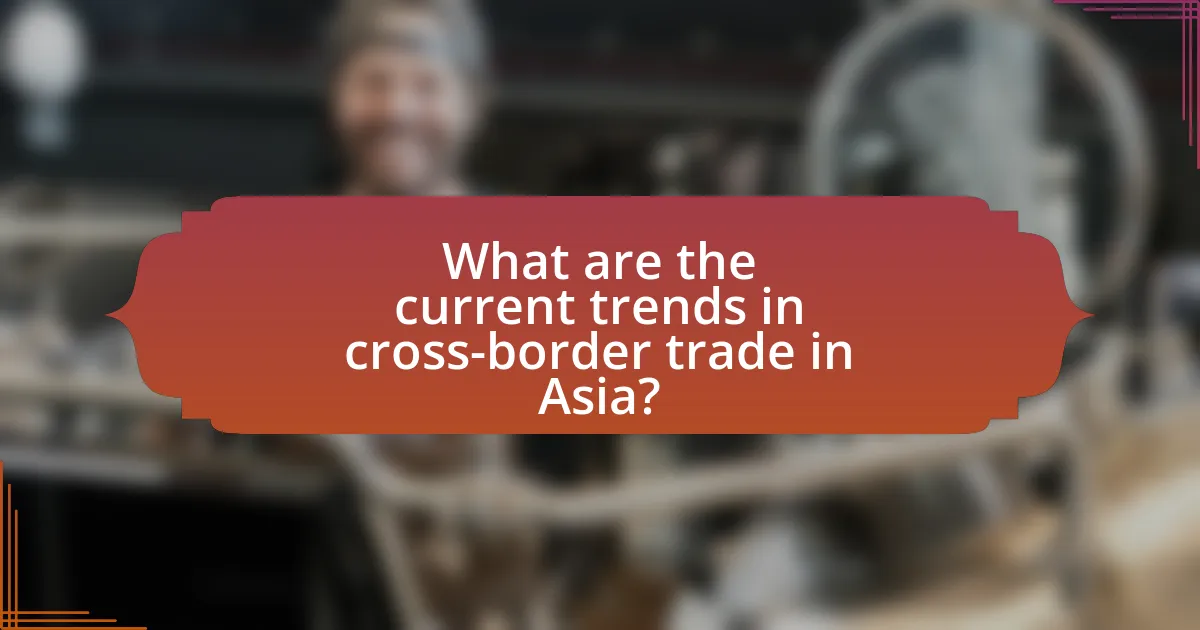The article provides insights into current trends in cross-border trade in Asia, highlighting the rise of digital trade platforms, increased regional trade agreements, and a focus on sustainability. It discusses the significant growth in trade volumes post-COVID-19, driven by demand for electronics and medical supplies, and examines the factors influencing these changes, including shifts in global demand and economic policies. The article identifies Southeast Asia as the most active region in cross-border trade, with China and the United States leading in trade activities. Additionally, it addresses challenges such as regulatory barriers and infrastructure deficiencies, while exploring the impact of technology and trade agreements on trade dynamics. Future trends, including digitalization and sustainability, are also analyzed, along with best practices for businesses engaging in cross-border trade in the region.

What are the current trends in cross-border trade in Asia?
Current trends in cross-border trade in Asia include the rise of digital trade platforms, increased regional trade agreements, and a focus on sustainability. Digital trade platforms, such as e-commerce marketplaces, have expanded access to international markets, facilitating smoother transactions. The Regional Comprehensive Economic Partnership (RCEP), which came into effect in 2022, exemplifies the trend of countries in Asia forming trade agreements to enhance economic cooperation and reduce tariffs. Additionally, there is a growing emphasis on sustainable trade practices, driven by consumer demand for environmentally friendly products and corporate responsibility initiatives. These trends reflect a dynamic shift in how Asian countries engage in cross-border trade, adapting to technological advancements and changing consumer preferences.
How have trade volumes changed in recent years?
Trade volumes in Asia have generally increased in recent years, reflecting a recovery from the disruptions caused by the COVID-19 pandemic. According to the Asian Development Bank, trade in goods and services among Asian economies rose by approximately 10% in 2021 compared to 2020, driven by strong demand for electronics and medical supplies. Additionally, the World Trade Organization reported that global merchandise trade volume increased by 8% in 2021, with Asia playing a significant role in this growth due to its manufacturing capabilities and export-oriented economies.
What factors are driving these changes in trade volumes?
Changes in trade volumes are primarily driven by shifts in global demand, supply chain disruptions, and trade policy adjustments. For instance, the COVID-19 pandemic significantly impacted supply chains, leading to delays and increased costs, which in turn affected trade volumes across Asia. Additionally, the rise of e-commerce has fueled demand for goods, resulting in increased trade activity. Trade agreements, such as the Regional Comprehensive Economic Partnership (RCEP), have also facilitated trade by reducing tariffs and enhancing market access among member countries, further influencing trade volume changes.
How do economic policies influence trade volume trends?
Economic policies significantly influence trade volume trends by shaping tariffs, trade agreements, and regulations that affect cross-border transactions. For instance, when a government lowers tariffs, it typically results in increased imports and exports, as seen in the implementation of the ASEAN Free Trade Area, which led to a 25% increase in intra-regional trade among member countries from 1993 to 2018. Additionally, economic policies that promote foreign direct investment can enhance trade volumes by attracting businesses that engage in international trade, as evidenced by China’s policies that have contributed to its status as the world’s largest exporter. Thus, the design and implementation of economic policies directly impact trade volume trends through their effects on market accessibility and competitiveness.
What regions in Asia are most active in cross-border trade?
Southeast Asia is the most active region in Asia for cross-border trade. This region, which includes countries like Vietnam, Thailand, and Malaysia, has seen significant growth in trade activities due to its strategic location and participation in various trade agreements, such as the ASEAN Free Trade Area. In 2021, intra-ASEAN trade reached approximately $669 billion, highlighting the region’s robust trade dynamics and economic integration efforts.
Which countries are leading in cross-border trade activities?
China and the United States are leading in cross-border trade activities. In 2022, China accounted for approximately $4.6 trillion in exports and imports, making it the largest trading nation globally. The United States followed closely with around $4.2 trillion in trade. These figures highlight the significant role both countries play in international trade, driven by their vast economies and extensive trade networks.
What are the emerging markets in cross-border trade within Asia?
The emerging markets in cross-border trade within Asia include Vietnam, India, and Bangladesh. These countries are experiencing rapid economic growth and increasing integration into global supply chains. For instance, Vietnam’s exports surged to $336 billion in 2021, driven by its manufacturing sector, while India’s trade with ASEAN countries reached $100 billion in 2022, highlighting its expanding role in regional trade. Additionally, Bangladesh’s garment industry, which accounts for 80% of its total exports, has positioned it as a key player in cross-border trade.
What challenges are faced in cross-border trade in Asia?
Cross-border trade in Asia faces several significant challenges, including regulatory barriers, infrastructure deficiencies, and varying customs procedures. Regulatory barriers often stem from differing trade policies and tariffs among countries, which complicate the movement of goods. Infrastructure deficiencies, such as inadequate transportation networks and logistics facilities, hinder efficient trade flow. Additionally, varying customs procedures can lead to delays and increased costs, as businesses must navigate different documentation and compliance requirements across borders. These challenges collectively impact the efficiency and profitability of cross-border trade in the region.
How do regulatory barriers impact trade flows?
Regulatory barriers significantly restrict trade flows by imposing additional costs and complexities on cross-border transactions. These barriers, such as tariffs, quotas, and stringent compliance requirements, can lead to increased prices for imported goods, thereby reducing demand. For instance, a study by the World Bank found that countries with high regulatory barriers experience a 20% decrease in trade volume compared to those with more streamlined regulations. Furthermore, lengthy customs procedures can delay shipments, resulting in lost sales opportunities and diminished competitiveness in global markets.
What role does infrastructure play in facilitating or hindering trade?
Infrastructure plays a crucial role in facilitating trade by enabling efficient transportation, communication, and logistics systems. Well-developed infrastructure, such as roads, ports, and railways, reduces transit times and costs, thereby enhancing trade volumes. For instance, the Asian Development Bank reported that improved infrastructure in Asia could increase trade by up to 30% by 2025, demonstrating the direct correlation between infrastructure quality and trade efficiency. Conversely, inadequate infrastructure can hinder trade by causing delays, increasing costs, and limiting access to markets, which negatively impacts economic growth and competitiveness.
How is technology influencing cross-border trade in Asia?
Technology is significantly influencing cross-border trade in Asia by enhancing efficiency, reducing costs, and facilitating real-time communication. The adoption of digital platforms, such as e-commerce and online payment systems, has streamlined transactions, allowing businesses to reach international markets more easily. For instance, the rise of platforms like Alibaba and JD.com has enabled small and medium-sized enterprises to engage in cross-border trade without the need for extensive infrastructure. Additionally, advancements in logistics technology, including automated warehousing and tracking systems, have improved supply chain management, leading to faster delivery times and reduced operational costs. According to a report by the Asian Development Bank, digital trade in Asia is projected to reach $1 trillion by 2025, underscoring the transformative impact of technology on cross-border trade in the region.
What technological advancements are shaping trade logistics?
Technological advancements shaping trade logistics include automation, artificial intelligence (AI), blockchain, and the Internet of Things (IoT). Automation enhances efficiency in warehousing and transportation, with robots and automated systems reducing labor costs and increasing speed. AI optimizes supply chain management by predicting demand and improving inventory control, leading to reduced waste and better resource allocation. Blockchain technology ensures transparency and security in transactions, facilitating trust among trading partners by providing an immutable record of goods. IoT devices enable real-time tracking of shipments, improving visibility and allowing for proactive management of logistics operations. These advancements collectively enhance the efficiency, reliability, and security of trade logistics, crucial for the growing cross-border trade in Asia.
How are digital platforms changing the landscape of cross-border trade?
Digital platforms are transforming cross-border trade by enhancing accessibility, reducing transaction costs, and streamlining logistics. These platforms enable businesses, especially small and medium enterprises, to reach international markets without the need for extensive infrastructure. For instance, e-commerce giants like Alibaba and Amazon facilitate cross-border transactions by providing integrated payment solutions and logistics support, which significantly lowers barriers to entry. According to a report by the Asian Development Bank, the use of digital platforms in Asia has led to a 20% increase in cross-border e-commerce transactions over the past five years, demonstrating their impact on trade dynamics.
What are the implications of trade agreements on cross-border trade?
Trade agreements significantly enhance cross-border trade by reducing tariffs and non-tariff barriers, thereby facilitating smoother transactions between countries. For instance, the ASEAN Free Trade Area (AFTA) has led to a 25% increase in intra-regional trade among member countries since its implementation in 1992. These agreements create a more predictable trading environment, encouraging investment and economic cooperation. Additionally, trade agreements often include provisions for customs procedures and regulatory harmonization, which further streamline cross-border trade processes. The World Trade Organization (WTO) reports that trade agreements can lead to an overall increase in trade volumes, as they promote market access and competitiveness among participating nations.
How do free trade agreements affect trade dynamics in Asia?
Free trade agreements (FTAs) significantly enhance trade dynamics in Asia by reducing tariffs and trade barriers among member countries. These agreements facilitate increased trade volumes, as evidenced by the ASEAN Free Trade Area, which led to a 25% increase in intra-ASEAN trade from 2000 to 2015. FTAs also promote economic integration, allowing countries to specialize in production based on comparative advantages, thereby improving efficiency and competitiveness in the region. Furthermore, FTAs attract foreign direct investment (FDI), as companies seek to capitalize on the preferential access to markets, which has been shown to boost economic growth in participating nations.
What are the benefits and drawbacks of regional trade agreements?
Regional trade agreements (RTAs) offer benefits such as increased trade volume, economic growth, and enhanced cooperation among member countries, while drawbacks include trade diversion, potential loss of sovereignty, and unequal benefits among members. The increase in trade volume is evidenced by the Association of Southeast Asian Nations (ASEAN) Free Trade Area, which has significantly boosted intra-regional trade since its establishment in 1992. However, trade diversion occurs when trade shifts from more efficient global producers to less efficient regional ones, potentially harming non-member countries. Additionally, member countries may face challenges in maintaining regulatory autonomy, as RTAs often require harmonization of standards and policies. The unequal benefits can lead to disparities, where stronger economies gain more than weaker ones, as seen in the Comprehensive and Progressive Agreement for Trans-Pacific Partnership (CPTPP).
What future trends can be anticipated in cross-border trade in Asia?
Future trends in cross-border trade in Asia include increased digitalization, enhanced logistics infrastructure, and a shift towards sustainability. Digitalization is expected to streamline trade processes through e-commerce platforms and blockchain technology, facilitating faster transactions and greater transparency. Enhanced logistics infrastructure, driven by investments in transportation networks and smart technologies, will improve efficiency and reduce costs. Additionally, a growing emphasis on sustainability will lead to the adoption of eco-friendly practices and regulations, influencing trade policies and consumer preferences. These trends are supported by the Asian Development Bank’s report on regional trade dynamics, which highlights the importance of technology and sustainability in shaping future trade landscapes.
How might geopolitical factors influence future trade patterns?
Geopolitical factors will significantly influence future trade patterns by altering trade agreements, tariffs, and supply chain dynamics. For instance, tensions between major economies, such as the United States and China, have led to increased tariffs and trade barriers, which directly impact the flow of goods and services. According to the World Trade Organization, global trade growth slowed to 1.2% in 2019, partly due to these geopolitical tensions. Additionally, regional alliances, such as the Regional Comprehensive Economic Partnership (RCEP) in Asia, can reshape trade routes and partnerships, promoting intra-regional trade while potentially sidelining non-member countries. These shifts illustrate how geopolitical considerations are pivotal in determining the future landscape of international trade.
What role will sustainability play in shaping future trade practices?
Sustainability will play a critical role in shaping future trade practices by driving the adoption of environmentally responsible methods and standards. As global awareness of climate change and resource depletion increases, businesses are increasingly required to implement sustainable practices to meet consumer demand and regulatory requirements. For instance, a report by the World Economic Forum indicates that 66% of consumers are willing to pay more for sustainable brands, highlighting the market shift towards sustainability. Additionally, trade agreements are increasingly incorporating sustainability clauses, which mandate adherence to environmental standards, thereby influencing cross-border trade dynamics in Asia and beyond.
What best practices can businesses adopt for successful cross-border trade in Asia?
Businesses can adopt several best practices for successful cross-border trade in Asia, including understanding local regulations, leveraging technology, and building strong relationships with local partners. Understanding local regulations is crucial, as compliance with customs, tariffs, and trade laws varies significantly across Asian countries. For instance, the ASEAN Free Trade Area facilitates reduced tariffs among member states, but businesses must still navigate specific national regulations. Leveraging technology, such as e-commerce platforms and digital payment systems, enhances efficiency and accessibility in cross-border transactions. Additionally, building strong relationships with local partners can provide valuable insights into market dynamics and consumer preferences, which are essential for tailoring products and services effectively. These practices collectively enhance operational efficiency and market penetration in the diverse Asian landscape.




